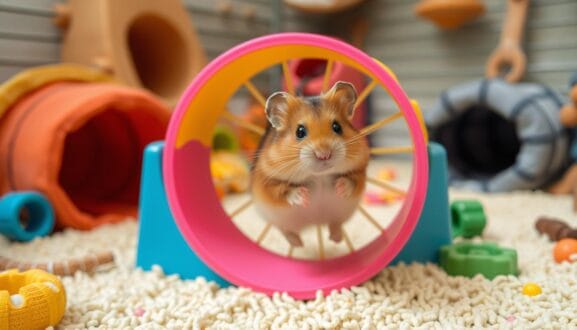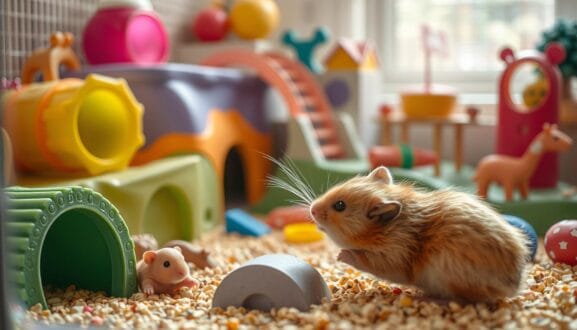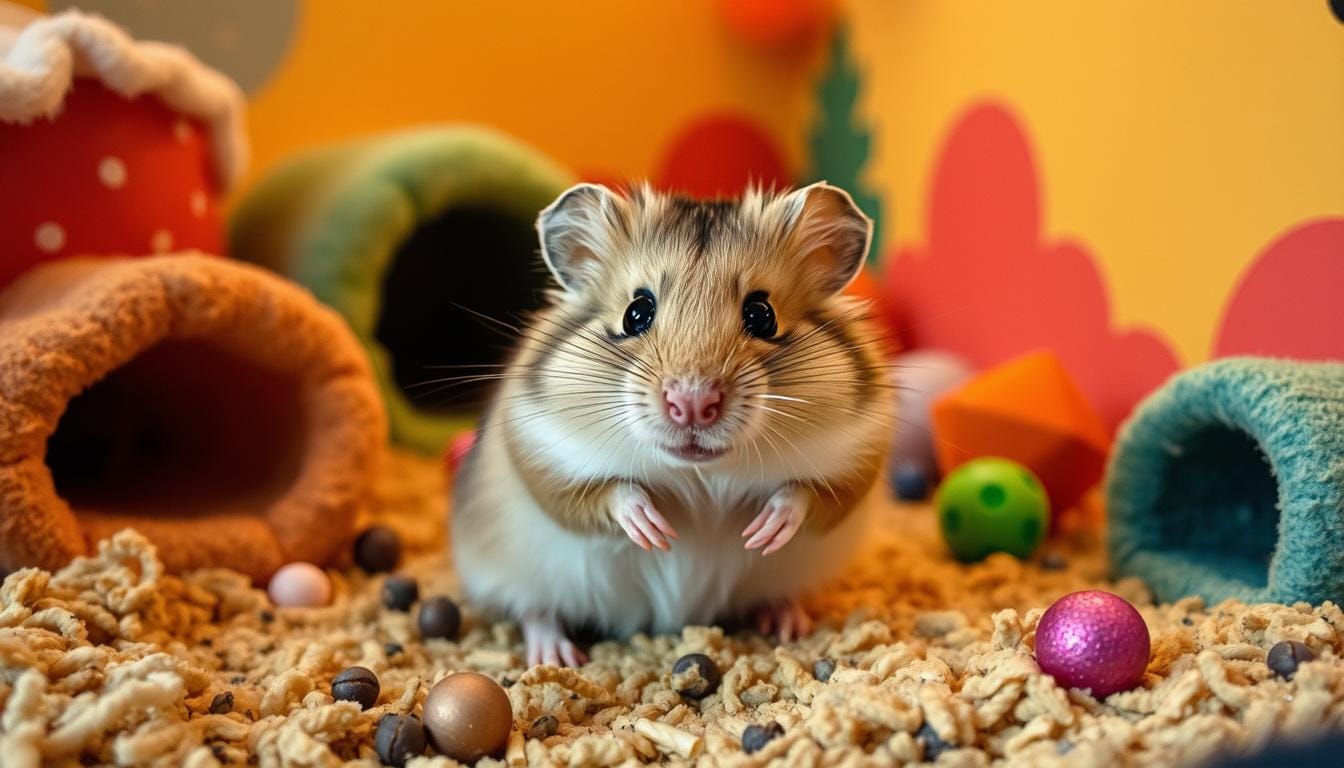Thinking about getting a small pet? The Chinese hamster might just surprise you. They have unique traits that set them apart from other pets. These little creatures have won the hearts of many pet lovers in the United States.
Wondering why Chinese hamsters are so special? It’s because of their fun behaviors and small size. They offer something unique that can brighten up your home. Let’s explore what makes them stand out.
- Introduction to Chinese Hamsters
- What Makes Chinese Hamsters Different from Other Hamster Species
- Setting Up the Perfect Habitat
- Chinese Hamster Dietary Requirements
- Daily Care and Maintenance Routine
- Understanding Chinese Hamster Behavior
- Health Considerations and Common Issues
- Socializing Your Chinese Hamster
- Breeding and Population Management
- Legal Considerations and Ownership Requirements
- Conclusion: Is a Chinese Hamster Right for You?
- FAQ:
- Are Chinese hamsters good pets?
- What is the difference between a Chinese Hamster and a normal hamster?
- Is a Chinese Hamster a dwarf?
- Do Chinese hamsters like to be held?
- Can 2 Chinese hamsters live together?
- Do Chinese hamsters climb?
- What do Chinese hamsters eat?
- What is the average lifespan of a Chinese hamster?
- Are there any legal restrictions on owning a Chinese hamster?
- How do I socialize my Chinese hamster?
- What are common health issues in Chinese hamsters?
- Can Chinese hamsters be kept alone or do they need companionship?
Introduction to Chinese Hamsters
Explore the fascinating world of Chinese hamsters. They are loved for their special traits and cute nature. Knowing about them helps you care for them better.
Origin and Natural Habitat
Chinese hamsters come from the dry deserts of northern China and Mongolia. These places shape their habitat. This affects their behavior and needs when kept as pets.
Physical Characteristics
Chinese hamsters are small and have long tails. Their fur is in many unique colors. These features make them even more charming.
Lifespan and Development Stages
Chinese hamsters live for 2 to 3 years. They go from playful pups to grown adults. Knowing their growth stages helps in caring for them well.
What Makes Chinese Hamsters Different from Other Hamster Species
Choosing the right hamster means knowing each species’ unique qualities. In a hamster species comparison, Chinese hamsters stand out. They have special traits that make them unique pets.
Chinese hamsters have unique hamster traits that set them apart. They have longer tails and a slender body. This makes them look different from Syrian or dwarf hamsters. They are also very curious and active, making them fun to be around.
Chinese hamsters need specific care. They do well in big spaces where they can climb and explore. Unlike some hamsters, they are not strictly night animals. This means they can fit into your daily schedule better.
Knowing these differences is key to giving your hamster the best life. Here’s a comparison to show how Chinese hamsters compare to other common species:
| Feature | Chinese Hamster | Syrian Hamster | Dwarf Hamster |
|---|---|---|---|
| Size | 3-4 inches | 6-7 inches | 2-3 inches |
| Tail Length | Longer than other species | Short | Variable |
| Activity Level | Moderate and curious | High and active | Varies by species |
| Habitat Needs | Spacious with climbing areas | Large cages with tunnels | Compact with exercise wheels |
Setting Up the Perfect Habitat
Creating a great environment is key for your Chinese hamster’s health and happiness. A well-thought-out hamster cage setup gives your pet lots of room to play and stay active.
Cage Size and Requirements
Your hamster needs a big home. A cage of at least 450 square inches is best. Make sure it has many levels and solid floors to avoid injuries.
Essential Equipment
Adding the right accessories makes your hamster’s life better. Here are some must-haves:
- Exercise wheel
- Tunnels and hiding spots
- Chew toys
- Food and water dispensers
Temperature and Lighting Needs
Keep the temperature between 65-75°F for your hamster’s comfort. Place the cage away from direct sunlight and drafts. It’s important to have 12 hours of light and 12 hours of dark to match their natural day-night cycle.
| Habitat Aspect | Requirements |
|---|---|
| Cage Size | Minimum 450 square inches |
| Temperature | 65-75°F |
| Lighting | 12 hours light / 12 hours dark |
| Essential Equipment | Exercise wheel, tunnels, hideouts, chew toys |
Chinese Hamster Dietary Requirements
It’s key to give your Chinese hamster a balanced diet. This diet helps them grow, stay energetic, and be healthy.
A good hamster diet has commercial food, fresh veggies, and treats now and then. Here are some good choices:
- High-quality hamster pellets or seeds
- Fresh veggies like carrots, broccoli, and spinach
- Small bits of fruits like apples or bananas
But, there are foods that are bad for your hamster:
- Citrus fruits and veggies
- Onions and garlic
- Chocolate and caffeine
- Processed or sugary foods
To keep your hamster healthy, follow these tips:
- Give fresh food every day and clean up leftovers
- Give treats sparingly to avoid weight gain
- Make sure they always have clean, fresh water
| Meal | Food Items |
|---|---|
| Breakfast | Hamster pellets, a small piece of carrot |
| Lunch | Fresh spinach, a few apple slices |
| Dinner | Hamster seeds mix, a tiny piece of broccoli |
Daily Care and Maintenance Routine
Having a regular hamster care routine keeps your Chinese hamster healthy and joyful. It stops illnesses and makes their home a great place to live.
Cleaning Schedule
Clean your hamster’s cage every week. Take out the dirty bedding and put in new one. Also, wash their food and water bowls every day to keep things clean.
Exercise Needs
Make sure your hamster gets to move a lot. Give them a wheel, tunnels, and places to climb. This keeps them fit and sharp-minded. Try to give them at least an hour of playtime each day.
Grooming Requirements
Hamster grooming is simple but important. Look over their fur for any tangles or mats. If needed, brush their fur gently. Also, trim their nails to stop them from getting too long.
| Task | Frequency |
|---|---|
| Cage Cleaning | Weekly |
| Wash Food & Water Containers | Daily |
| Provide Exercise | Daily, 1 hour |
| Grooming Check | Weekly |
Understanding Chinese Hamster Behavior
Watching your Chinese hamster can tell you a lot about its happiness. By noticing hamster behavior, you can meet its needs better.
- Burrowing: Creating tunnels and nests is a natural instinct.
- Hoarding: Storing food helps them prepare for times when food might be scarce.
- Nocturnal Activities: Most active during the night, they enjoy exploring and playing after dark.
It’s important to understand your hamster’s body language. Different movements and gestures can mean different things.

Seeing signs of stress, like hiding too much or being aggressive, means you need to make changes. On the other hand, a happy hamster will be calm and enjoy spending time with you. By understanding hamster body language, you can build a stronger bond and keep your Chinese hamster happy and healthy.
Health Considerations and Common Issues
Keeping your Chinese hamster healthy is key for their happiness. Knowing about hamster health lets you spot and fix problems early.
Signs of Illness
Look out for changes in how they act or look. Common signs include:
- Loss of appetite
- Difficulty breathing
- Unusual lumps or bumps
- Changes in fur condition
Preventive Care
Keep your hamster healthy by:
- Providing a balanced diet
- Keeping the cage clean
- Ensuring regular exercise
- Monitoring for early signs of illness
When to Visit a Vet
If your hamster shows persistent symptoms or severe changes, get vet care right away. Early action can stop hamster illnesses from getting worse.
| Illness | Symptoms | Treatment |
|---|---|---|
| Respiratory Infections | Labored breathing, sneezing | Antibiotics prescribed by a vet |
| Dental Problems | Overgrown teeth, difficulty eating | Trimming teeth by a professional |
| Skin Conditions | Redness, hair loss | Topical treatments as advised by a vet |
Socializing Your Chinese Hamster
Socializing your Chinese hamster can lead to a rewarding bond. It requires patience and understanding of their natural behavior.
Training Tips
- Start with short, gentle handling sessions daily.
- Use treats to encourage positive associations.
- Teach your hamster to come when called using a consistent cue.
Building Trust
Building trust with your Chinese hamster involves creating a safe and stress-free environment. Let your hamster approach you on its own terms. Avoid sudden movements that might scare them.
Regular interaction helps your hamster become comfortable with your presence. This makes socialization easier over time.

Breeding and Population Management
Responsible hamster breeding is key for happy and healthy Chinese hamsters. It helps control the pet population. This way, each hamster gets the care it deserves.
Breeding can be tough, like keeping genetic diversity and avoiding health problems. Choosing healthy pairs lowers the risk of inherited diseases. It also leads to stronger babies.
Good breeding needs careful planning and management. Here are some ways to control the pet population:
- Limit the number of breeding pairs to prevent excess litters.
- Regularly monitor the health of breeding hamsters to ensure they are fit for reproduction.
- Find suitable homes for all offspring to avoid overcrowding.
By focusing on responsible hamster breeding and managing the pet population, you help your Chinese hamsters thrive. This ensures their well-being and long life.
Legal Considerations and Ownership Requirements
Before getting a Chinese hamster, it’s key to know the pet laws in your area. These laws help keep you and your pet safe and legal.
State Regulations
Pet laws differ by state, impacting how you care for your Chinese hamster. Some places have special rules for exotic pets.
- California: Requires permits for certain exotic animals.
- Texas: Less restrictive but still advises responsible ownership.
- New York: Specific guidelines on cage size and care standards.
Required Documentation
To follow hamster laws, you might need certain papers:
- Pet License: Some states need you to register your hamster.
- Health Certificate: Shows your hamster is healthy and disease-free.
- Permit Application: Needed for some breeds or exotic species.
| State | Regulation | Required Documentation |
|---|---|---|
| California | Permits needed for exotic pets | Pet License, Health Certificate |
| Texas | General ownership laws | Pet License recommended |
| New York | Specific care standards for cages | Health Certificate, Cage Compliance |
Conclusion: Is a Chinese Hamster Right for You?
Thinking about getting a Chinese hamster is a big decision. These pets are special because of their unique traits. They are small and have charming personalities, making them a great choice for many.
Remember, caring for a hamster is a big responsibility. You’ll need to feed them regularly, clean their cage, and spend time with them. Knowing how to care for a hamster is key to their happiness.
Before getting a hamster, ask if you can handle the daily tasks. Can you deal with health issues and provide the care they need? Also, think about your home and if it’s right for a hamster.
If you’re ready for a Chinese hamster, look for a good breeder or adoption center. Local pet stores and shelters can help you find a healthy pet. This will make your decision a rewarding one.
By considering these points, you can decide if a Chinese hamster is right for you. This will ensure a happy life for both you and your pet.
FAQ:
Are Chinese hamsters good pets?
Chinese hamsters make excellent pets for dedicated caregivers. Their small size and gentle demeanor appeal to enthusiasts seeking a quiet companion. Though shy initially, they bond well with consistent handling. Proper care, including a spacious cage and mental stimulation, ensures a fulfilling environment, allowing the Chinese hamster to thrive in a domestic setting.
What is the difference between a Chinese Hamster and a normal hamster?
Chinese hamsters are smaller. They have a longer tail and unique colors. They also act differently than Syrian and dwarf hamsters.
Is a Chinese Hamster a dwarf?
The Chinese hamster is often mistaken for a dwarf species due to its compact size. However, it belongs to a distinct classification, differing anatomically from true dwarf hamsters like Roborovski or Campbell’s. With its slender body and long tail, the Chinese hamster exhibits unique characteristics that set it apart within the hamster family.
Do Chinese hamsters like to be held?
Chinese hamsters can develop a tolerance for being held, but their preference leans towards minimal handling. These delicate rodents often appreciate a calm and gentle approach. Patience is essential when taming them, as abrupt movements can cause stress. Gradually earning their trust fosters a more interactive bond with these naturally timid creatures.
Can 2 Chinese hamsters live together?
Housing two Chinese hamsters together often leads to territorial disputes, as these rodents are typically solitary by nature. While they may tolerate each other in rare cases, their natural tendency is to assert dominance. It’s advisable to provide separate enclosures to ensure their well-being and minimize the risk of aggressive confrontations.
Do Chinese hamsters climb?
Chinese hamsters are agile creatures known for their climbing prowess. Despite their small size, Chinese hamsters exhibit remarkable dexterity, effortlessly scaling cages and accessories. Their natural inclination to explore vertical spaces stems from their wild instincts. Providing climbing toys and secure enclosures ensures a safe environment for these energetic, inquisitive rodents.
What do Chinese hamsters eat?
Chinese hamsters need a balanced diet. This includes high-quality hamster food, fresh veggies, and sometimes treats. Stay away from sugary or processed foods to keep them healthy.
What is the average lifespan of a Chinese hamster?
Chinese hamsters can live for 2 to 3 years. This is if they get the right care and live in a healthy place.
Are there any legal restrictions on owning a Chinese hamster?
Laws about owning Chinese hamsters vary by state. Always check your local laws and get any needed permits before getting a Chinese hamster.
How do I socialize my Chinese hamster?
To socialize your Chinese hamster, handle them gently and interact with them often. Start by letting them get used to you before handling them a lot.
What are common health issues in Chinese hamsters?
Chinese hamsters can get respiratory infections, dental problems, and skin issues. Keeping an eye on them and taking preventive steps can help them stay healthy.
Can Chinese hamsters be kept alone or do they need companionship?
Chinese hamsters usually like to be alone. Putting them with other hamsters can cause territorial behavior and stress.

